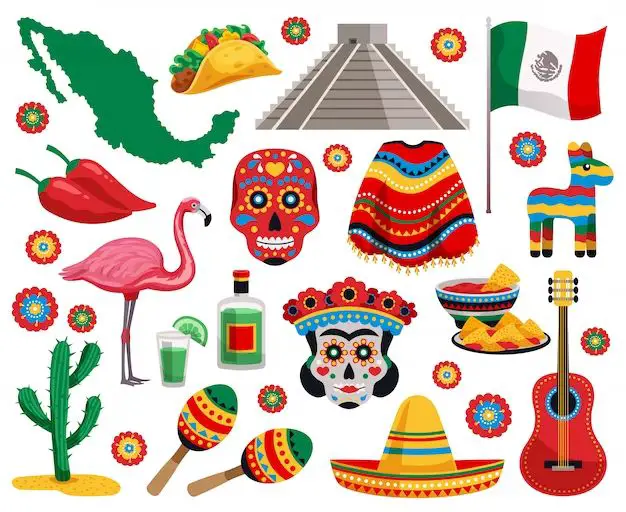Hispanic culture is rich with meaningful and beautiful traditions, symbols, and practices. Many of these have roots tracing back hundreds or even thousands of years to ancient traditions in countries like Spain, Portugal, and the indigenous cultures of Central and South America. Understanding these symbols and their origins provides insight into Hispanic cultural identity and heritage. Here are some of the most notable traditional Hispanic symbols and their meanings.
Religious Symbols
Catholicism has had an enormous influence on Hispanic culture, especially with Spain’s expansion into the Americas which began in 1492. As a result, many traditional Hispanic symbols relate to Catholic practices and beliefs.
The Cross
The cross is likely the most ubiquitous symbol in Hispanic Catholic tradition. Crosses come in many forms including the basic Latin cross, the Jerusalem cross with extra beams, and regional variations like the Yucatan cross with looped ends. Crosses represent the central Catholic belief in Jesus’s crucifixion and resurrection. They adorn churches and homes and are worn as necklaces in daily life.
The Virgin Mary
Mary, the mother of Jesus, is revered by Catholics for her virtue and role in Christ’s life. She is honored with many titles based on apparitions and miracles associated with her, such as Our Lady of Guadalupe in Mexico. Statues and images of Mary are common in Hispanic Catholic homes and churches.
Saint Medals
Catholics wear or carry medals depicting saints for spiritual protection and to commemorate their admirable lives. Some saints popular among Hispanics include St. Christopher, St. Anthony, St. Jude, and Our Lady of Charity. Each saint has special meaning, like St. Christopher who protects travelers.
Rosary Beads
Rosaries are strings of beads used by Catholics to guide prayers and meditations, often directed at Mary or Jesus. The repetitive practice creates ritual and spiritual focus. Rosary beads hold personal meaning for many Hispanic Catholics.
Indigenous Symbols
Many symbols used in modern Hispanic culture originate from the ancient belief systems of Central and South America’s indigenous peoples. These symbols reflect the local myths and spirituality of their unique cultures.
Quetzalcoatl
The feathered serpent deity known as Quetzalcoatl was extremely important in Aztec, Mayan, and other Mesoamerican religions. It represents the creator god and fertility. Images of the feathered snake highlight ancient indigenous influence in Mexico.
Pachamama
Pachamama is an Andean Mother Earth goddess still revered by many indigenous people in countries like Peru and Bolivia. She represents nature, fertility, and the cycle of life. Offerings to Pachamama are common during planting and harvesting.
Ceiba Tree
The ceiba tree was sacred in Mayan cosmology as the tree of life connecting the mortal world to the spirit realm. Its huge roots and height make it an imposing natural presence. The ceiba tree is an important cultural and spiritual symbol for many indigenous groups past and present.
Chaski
The chaski were Inca messengers who transmitted information quickly through a relay system of running. They carried intricately knotted cords called quipu which encoded messages through the knots’ meanings. The chaski symbolize communication, teamwork, and speed.
National Symbols
Hispanic countries proudly display national symbols which express shared culture and history. These patriotic symbols are seen on currency, flags, seals, and in anthems.
Coat of Arms
The distinctive coat of arms of each Hispanic country encapsulates symbolic elements of its history and geography. For example, Cuba’s includes a laurel wreath, key, andrising sun. Guatemala’s depicts the quetzal bird and scrolls with Mayan dates.
Flags
The vibrant flags of Hispanic nations hold meaningful symbols and colors tied to their national identity. The Mexican flag features iconic eagle and snake imagery atop a cactus. Chile’s flag contains a whitestar symbolizing progress and blue for the sky.
Currencies
National currencies often depict important leaders, landscapes, or structures. The Cuban peso includes an image of independence hero José Martí. The Chilean 500 peso banknote highlights modern architecture. Currencies are moving national symbols.
Anthems
Lyrics and melodies of national anthems inspire patriotism and connect citizens to shared struggles and principles. For example, the Himno Nacional Mexicano glorifies the defend ers who fought for Mexico’s freedom and independence.
Cultural Symbols
In addition to religious, indigenous, and patriotic symbols, some noteworthy representations embrace broader Hispanic culture and identity.
La Calavera Catrina
This iconic skeleton figure from Mexican culture symbolizes the human inevitability of death. She is dressed elegantly as a fine lady, reflecting the equality of all in facing mortality. La Catrina is especially celebrated during the Day of the Dead festival.
Papel Picado
Papel picado are decorative cut paper banners used for Mexican and Central American holiday celebrations. The delicate, lace-like perforations create beautiful designs and reflect cultural pride in skilled papercraft. They bring vibrant color and festivity to events.
Flamenco Fan
The flamenco dance style originated with Spain’s Roma people but became mainstream over centuries. The flamenco fan is an essential rhythmic prop for dancers, representing the passion and movement of flamenco. Fans complement the characteristically swift footwork.
Tango
Born in Argentina and Uruguay, the dramatic tango dance is now iconic of Hispanic culture worldwide. The tango reflects themes of romance, heartbreak, and quick movement. Its tradition lives on through dance partners’ synchronized steps and upper body contact.
Conclusion
Hispanic cultural symbols emerge from histories stretching back centuries while also incorporating more recent national identities. These symbols speak to shared values, religious beliefs, indigenous mythology, patriotic pride, and popular artistic expressions. Displaying and understanding traditional Hispanic symbols provides deeper connection to the cultures of Spanish-speaking peoples across North, Central, and South America as well as Europe. The symbols form an important part of Hispanic heritage and collective memory.


